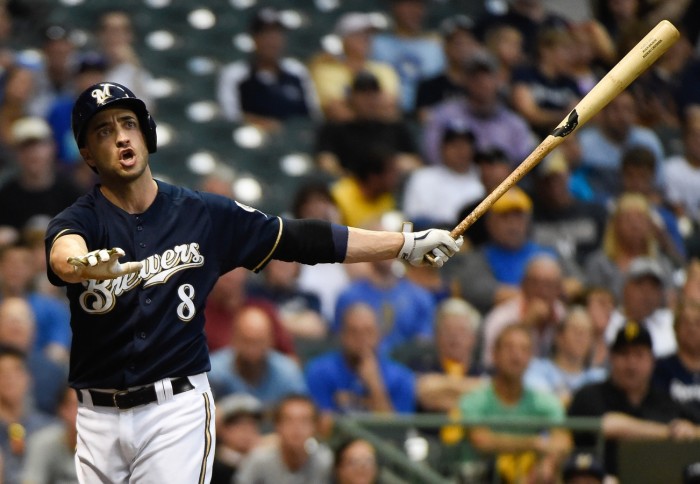If there’s one thing that sabermetricians love, it’s projections. What can top an algorithm that tells you how well someone will play? Nothing, in our books. But problems can arise when those algorithms inevitably disagree with one another. In those situations, we have to roll up our sleeves and dive into the numbers, to try and reach a solid conclusion between the opposing systems.
Yesterday, Henry Druschel, my colleague at Beyond the Box Score (and a writer for BP Wrigleyville), took a look at the wide gap in projections for the Rays. BP thinks they’ll win 91 games, based on PECOTA; FanGraphs combines ZiPS and Steamer to give them an 81-win projection. After bringing up the 10-win gap, he casually noted the following:
[T]he next-largest difference in win percentage between FG and BP is .038, for the Brewers, which translates to a mere six games.
The size of the disparity aside, this blog covers the Brewers, so I thought I’d take a closer look at this. Why does FG predict a 72-90 season and BP a 78-84 one?
The difference stems from both offense and defense, as PECOTA takes a more bullish outlook on the Brewers’ run scoring and run prevention:
| System | RS/G | MLB Rank | RA/G | MLB Rank |
|---|---|---|---|---|
| BP | 4.25 | 15th | 4.43 | 21st |
| FG | 4.12 | 24th | 4.66 | 27th |
On a macro level, there aren’t too many disagreements between the two systems. We’ll look at where each position ranks in the major leagues, instead of comparing wins above replacement straight-up, since the two sites use different definitions of replacement level. The projections really diverge in four places:
| System | C Rank | 1B Rank | 2B Rank | SS Rank | 3B Rank | LF Rank | CF Rank | RF Rank | SP Rank | RP Rank |
|---|---|---|---|---|---|---|---|---|---|---|
| FG | 8th | 22nd | 24th | 25th | 29th | 8th | 25th | 18th | 26th | 14th |
| BP | 6th | 22nd | 25th | 17th | 28th | 1st | 29th | 22nd | 23rd | 18th |
BP thinks more highly of Jonathan Lucroy, Jonathan Villar, and Ryan Braun than FG does. In the starting rotation, Wily Peralta gets the biggest boost; the rest comes from disagreements about playing time (FG thinks Matt Garza will appear pretty often, and BP thinks Zach Davies will replace him a bit more).
We’ll begin with Lucroy. He had a horrible 2015, and FG and BP don’t know if he’ll bounce back. The dispute, as you might have guessed, comes down to defense. The former pegs him at 2.3 runs above average, whereas the latter thinks he’ll give Milwaukee 14 runs. Even though his framing fell off a cliff last season, Lucroy’s impressive and lengthy defensive resume gives me confidence. In each of his first five major-league seasons, he surpassed 14 runs with the glove, and I’d bet on him doing it again in year seven.
Now let’s move on to Braun. According to fWAR, he gave the Brewers 2.7 wins over 568 plate appearances last season. FG projects him to again post 2.7 fWAR in 2016, but in 635 trips to the dish. By contrast, BP thinks he’ll double his 2015 production: He accrued 2.4 WARP last year, and he’ll theoretically accumulate 4.8 this year. Theory and practice are two different things, though. PECOTA’s hopefulness boils down to defense — it predicts a six-run campaign in the field. Given that Braun cost the Brewers 11.6 runs defensively in 2015 and has cost them 24.6 runs over the course of his career, I’d expect him to fulfill that.
Then there’s Jonathan Villar. He has 658 lifetime plate appearances, over which he’s earned -0.3 fWAR and 2.0 WARP. That’s a massive gap, which explains why PECOTA likes him more than Steamer and ZiPS do. As with Lucroy and Braun, the difference comes from defense — UZR says Villar has been worth -20.4 runs, and FRAA says he’s been worth -0.3 runs. We can’t easily mediate a rift that massive; simply because of the messiness of aging curves, I’ll take the under here, but you can just as easily think he’ll remain an average defender.
On the pitching side of things, Peralta also had a down year in 2015, with a middling 4.72 ERA across 108.2 innings. PECOTA projects a 4.44 ERA, while ZiPS and Steamer combine for a 4.54 mark. I discussed Peralta’s breakout potential earlier in the offseason; if he can regain the velocity he lost last year and hold onto the movement he picked up, he’ll have a good shot of meeting the PECOTA projection. Then again, velocity tends to stay away once it leaves, so I wouldn’t bet on it.
In the end, the evidence seems to support the FG side of things. 2016 just doesn’t look like the Brewers’ year. Braun’s stardom has come and gone, Villar’s defense won’t get any better, and Peralta likely won’t reach his potential. But that isn’t to say that the season will be a wash. Even if Milwaukee doesn’t win as frequently as BP suggests, the younger players it tries out will bring hope for the future. Perhaps in 2017 and 2018, the projections will take a more unanimously optimistic view.

Identifying risk iis a 3 is step process; Determine the danger, rate the
danger and growing a constructive and sensible mootion plan for thee danger(s).